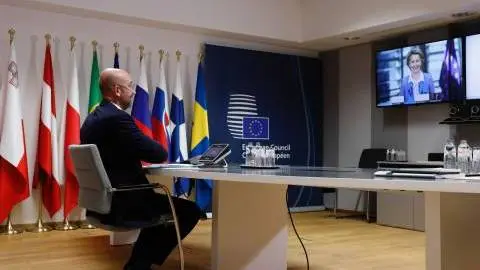Italy: Still in emergency mode
Unfavourable lockdown accounting has been calling for compensating temporary measures so far. Looming use of EU facilities should help mark a change in shift towards a forward-looking approach
First hit first to lock down
Italy was hit first among European countries by the Covid-19 pandemic. Early local lockdowns turned into a nationwide lockdown on 8 March.
Google Covid-19 local mobility data shows that the Italian implementation of social distancing measures was relatively strict from the very beginning and this was reflected in the 5.3% QoQ (-5.4% YoY) contraction of GDP in 1Q20, unsurprisingly driven by private consumption and investment components.
A trio of fiscal packages
The strict social distancing rules imposed mandated closures of many economic activities, called for a set of measures meant to mitigate their social and economic impact.
The Italian government put in place three fiscal packages between 15 March and 20 May, combining direct fiscal impulse with sizeable tax and loan deferrals, liquidity-enhancing measures and loan guarantees.
The May decree, dubbed Relaunch decree, was aimed at refinancing many measures introduced before while widening their scope to businesses formerly left-out and simplifying their rules to let the money reach more eligible parties.
Keeping people on the books
On the household front, a lot of effort was put in to keeping people in jobs by freezing layoffs until the end of August and reinforcing and extending an existing unemployment insurance plan (CIG), now funded until October 2020. Self-employed and autonomous workers and working parents were compensated with monthly monetary bonuses.
Businesses were directly helped through tax payment deferrals and debt moratoria, and indirectly with the possibility to tap state-guaranteed funding from banks and other state-owned vehicles. In the May Relaunch decree, some tax cancellations were introduced along with measures to rescue the battered tourism sector.
EU funding to enter the scene
The three fiscal packages, amounting to a total of €80 bn (excluding guarantees) were apparently compensatory in nature and deliberately aimed at tackling the emergency while lacking any emphasis on the planning of a post-pandemic future.
The forward-looking angle has recently gained centre stage in the political debate after it has become clear that the future availability of the EU recovery funds will be conditional on a sound portfolio of projects. So long as economic and epidemic uncertainties aren't dispelled, medium-term strategic reform plans and short-term emergency measures will have to proceed in tandem.
We believe labour protection will remain a priority but whether Italy requests access to the ESM pandemic credit line remains an open question
We believe that labour protection will remain a priority and that the relevant funding could likely come from the SURE EU vehicle. Whether Italy will also request access to the ESM pandemic credit line remains an open question. The government coalition is still in disagreement: the PD, Italia Viva, and Liberi e Uguali are in favour, and the 5SM is still against. PM Conte, after some ambiguity, is trying to mediate.
Before taking the final decision, the prime minister will likely wait to see what the ongoing discussion on the EU recovery fund will be. If available resources prove smaller than hoped and the economic rebound is weak, he could have a hard time giving up the opportunity to get some €36 bn of non-marketable, long tenor, almost unconditional cheap funding from the ESM.
Beware of the upcoming round of delayed regional elections now expected late in September. They also might impact the timing of the decision on the ESM.
As lockdowns ease, re-opening isn't easy
In the meantime, positive developments on the epidemic front have allowed PM Conte to progressively loosen the strictness of the lockdown, upon respect of precautionary distancing rules.
Manufacturing and construction activities were re-opened on 4 May, retail activities a week later and bars and restaurants on 18 May. Inter-regional personal mobility and inbound flows of EU citizens, key ingredients for tourism activities, were allowed since 2 June. The easing of the lockdown has been timely reflected by Google Covid-19 mobility data: the gap versus pre-Covid times is shrinking, but it is far from filled. This is hardly surprising, as for many firms, particularly the smallest ones, obeying to the new precautionary sanitary rules is proving very difficult.
For many firms operating in the sector of hospitality and restaurants, strict obeyance might prove incompatible with their low margin, high volume business models.
Too early to make any calls on the tourism sector
After just a few days of the re-opening of borders it is too soon to make any calls on how the tourism season will unfold.
Given that international tourist flows will hardly compare with the past, domestic business operators are overtly inviting Italian tourists to remain within the national borders. Given the dominance of domestic over international spending in the tourism and travel sector, this might prove a reasonable defensive strategy.
Proximity might be the keyword this Summer.
Similar pattern, bigger scale for 2Q20 GDP QoQ contraction

Expect an even steeper GDP contraction in 2Q20
Based on lockdown-time accounting, it seems inevitable that in 2Q20, Italian growth will post a steeper QoQ decline than the -5.3% recorded in 1Q20.
PMI data has signaled a turnaround in May, clearly more marked in manufacturing than in services, but the order component confirmed disappointingly soft. A gradual recovery in May and June would hardly be enough to compensate for the April full-month lockdown.
While anticipating a decent rebound over 3Q20, for the time being we stick to our call for a 9.8% average GDP contraction in 2020.
The Italian economy in a nutshell (%YoY)
Download
Download article
22 June 2020
Eurozone Quarterly: The gradual, but not great, re-opening This bundle contains 15 articlesThis publication has been prepared by ING solely for information purposes irrespective of a particular user's means, financial situation or investment objectives. The information does not constitute investment recommendation, and nor is it investment, legal or tax advice or an offer or solicitation to purchase or sell any financial instrument. Read more
